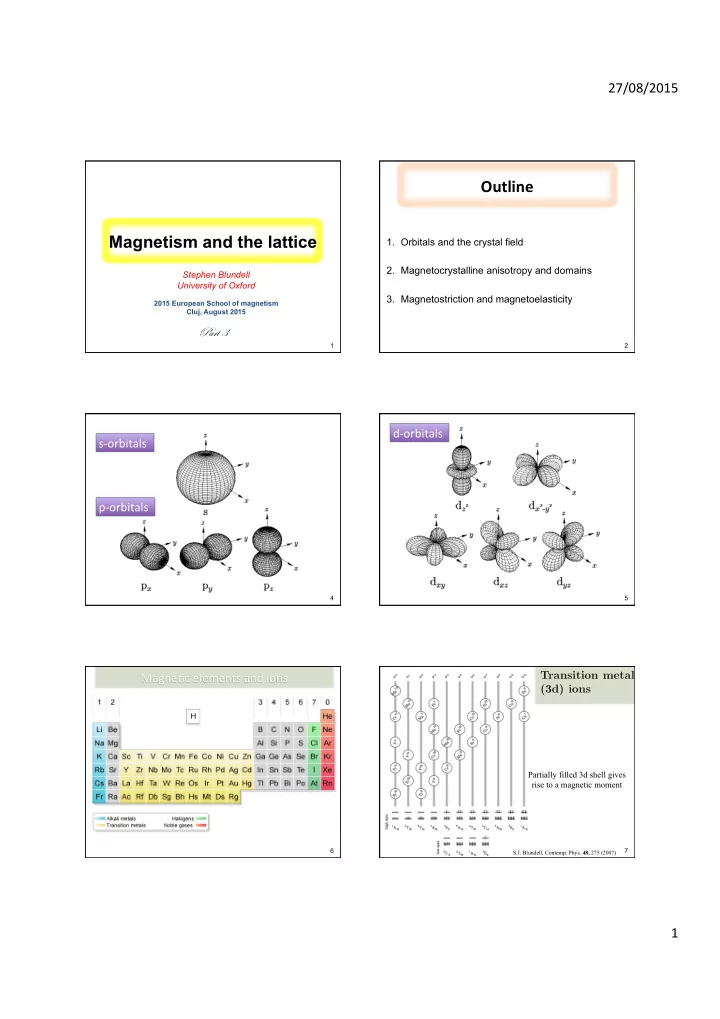

27/08/2015 ¡ Outline ¡ Magnetism and the lattice 1. Orbitals and the crystal field 2. Magnetocrystalline anisotropy and domains Stephen Blundell University of Oxford 3. Magnetostriction and magnetoelasticity 2015 European School of magnetism Cluj, August 2015 ¡ Part 3 1 2 d-‑orbitals ¡ s-‑orbitals ¡ p-‑orbitals ¡ 4 5 Magne8c ¡elements ¡and ¡ions ¡ Transition metal (3d) ions Partially filled 3d shell gives rise to a magnetic moment 6 7 S.J. Blundell, Contemp. Phys. 48, 275 (2007) 1 ¡
27/08/2015 ¡ Transition metal (3d) ions Cu II = 3d 9 Partially filled 3d shell gives rise to a magnetic moment 8 S.J. Blundell, Contemp. Phys. 48, 275 (2007) A parable: p-orbitals A parable: p-orbitals m = 0 cos θ Y lm ( θ , φ ) l = 1 m = 1 sin θ e i φ m = − 1 sin θ e − i φ L z = − i � ∂ ˆ | m � imaginary, eigenfunctions ∂φ | p z � = | 0 � note that these contain | p x ⇥ = | 1 ⇥ + | � 1 ⇥ ⇤ | m � the eigenfunctions and 2 in equal mixtures | � m ⇥ | p y ⇥ = | 1 ⇥ � | � 1 ⇥ real eigenfunctions, for V(r) which is real ⇤ 12 2 i 13 2 ¡
27/08/2015 ¡ d-‑orbitals ¡ d-‑orbitals ¡ | 2 , ± 2 i sin 2 θ e ± 2i φ | 2 , 0 i 3 cos 2 θ − 1 | 2 , ± 1 i sin θ cos θ e ± i φ 14 15 Jahn-Teller distortion in a 3d 4 ion 16 17 3 ¡
27/08/2015 ¡ Goodenough-Kanamori-Anderson (GKA) rules e g orbitals 1. Exchange interaction of two half-filled orbitals is strong and antiferromagnetic 2. If this overlap is at 90 o , exchange interaction is weak and ferromagnetic 3. Exchange interaction of half-filled with empty (or doubly-occupied) orbital is weak and ferromagnetic 20 21 e g orbitals weak, FM strong, AF 22 23 t 2g orbitals t 2g orbitals 4 ¡
27/08/2015 ¡ The next revolution? Magnetic molecules The next revolution? Magnetic molecules S =17/2 S =10 ¡ S =10 ¡ S =6 S =33/2 S =12 S =83/2 S =0 S =1/2 Single molecule magnets Small molecular clusters with moments Hamiltonian is which couple so that S is large H = - DS z 2 + other terms Possibility of tunnelling when B = nD /g µ B so for D >0, ground state is S z =±10 D>0 B=0 increasing B Mn 12 energy levels Fe 8 energy levels 5 ¡
27/08/2015 ¡ U=5000 K Mn 12 Fe 8 U=K x Volume Outline ¡ 1. Orbitals and the crystal field 2. Magnetocrystalline anisotropy and domains 3. Magnetostriction and magnetoelasticity Compasses work! 35 • Shape anisotropy Magnetocrystalline anisotropy in elemental ferromagnets { (from JMD Coey lecture) hexagonal cubic • Volume anisotropy E a = K 1 ( α 2 1 α 2 2 + α 2 2 α 2 3 + α 2 3 α 2 1 ) + K 2 α 2 1 α 2 2 α 2 • Surface anisotropy 3 6 ¡
27/08/2015 ¡ ~ Magnetocrystalline anisotropy M = ( M 1 , M 2 , M 3 ) M 1 α 1 = cos θ 1 = p M 2 1 + M 2 2 + M 2 3 4 K 1 + 1 1 16 K 3 + · · · Origin of magnetocrystalline anisotropy: spin pair model Bloch wall Néel wall But also have to consider intrinsic single-ion effects (via spin-orbit) Thin film case Outline ¡ ¡ ¡ E a = K sin 2 θ Angle between surface normal and M 1. Orbitals and the crystal field ¡ Surface anisotropy ¡ ¡ Shape anisotropy ¡ 2. Magnetocrystalline anisotropy and domains ¡ K = 2 K s + K v − 1 ¡ 2 µ 0 M 2 t 3. Magnetostriction and magnetoelasticity Volume anisotropy Film thickness ¡ ¡ ¡ ¡ 44 7 ¡
27/08/2015 ¡ Does the sample come apart when it magnetizes? No, but magnetization leads to stresses and this an energy contribution that must be considered N N N S N S S S Spin ice Dy 3+ 4f 9 S=5/2, L=5 J=15/2 6 H 15/2 • Pyrochlore structure • Network of corner-sharing tetrahedra • In Dy 2 Ti 2 O 7 , Dy 3+ on corners • Ising spins along <111> • Nearest-neighbour ferromagnetic • System frustrated • No order at low temperature • = Spin ice [Harris, Bramwell et al. PRL 79, 2554 (1997) Uses analogy between statistical mechanics in r · M = 0 spin ice and water ice 2-in 2-out rule 8 ¡
27/08/2015 ¡ − µ 0 Q 2 4 π R North and South poles have been separated – and can move independently! A. Ryzhkin, JETP 101 , 481 (2005). C. Castelnovo, R. Moessner, and S.L. Sondhi, Nature 451 , 42 (2008). r · H = �r · M 6 = 0 r · B = 0 Are these monopoles real? My view: emergent particles are real! Holes, magnons, phonons, photons, electrons · · · 9 ¡
Recommend
More recommend